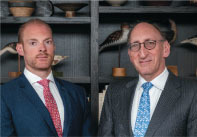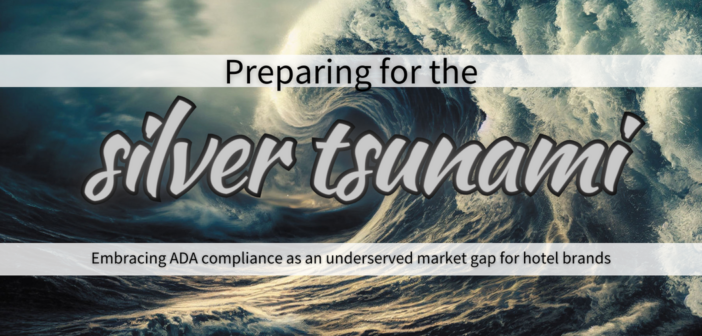Embracing ADA compliance as an underserved market gap for hotel brands
The hotel industry has exploded with new brands and sub-brands during the past two decades, and this trend isn’t going to stop anytime soon. While there are a variety of forces and incentives at play to account for this diversification, one prominent rationale is that emergent brands often can better appeal to niche interests, microsegments, or customer identities.
To wit, look no further than the growth of the extended-stay category (such as Home2 Suites by Hilton, Residence Inn by Marriott, Hyatt House) and serviced apartment or aparthotel brands. Others skewing more to the premium and luxury segments have excelled by homing in on a specific value system for communicating their brand equity, be it rigorous sustainability (1 Hotels), extravagant wellness (Aman, Hyatt Andaz, Mandarin Oriental, Six Senses), fitness (Accor’s Pullman, IHG’s EVEN, Equinox Hotels) or nightlife (Kimpton, Moxy, The W), in addition to the bevy of brands, soft brands, and associations tinkering in spaces like lifestyle, design, art, and culinary-forward.
While the list of hotel brands across the globe may now require a Ph.D. to effectively memorize and distinguish between each, we posit there’s one major customer cohort yet to be properly embraced at the operational and marketing levels – those guests with disabilities. Of course, hotels within the United States must adhere to statutes inscribed by the Americans with Disabilities Act (ADA), but this often comes down to doing the passable minimum insofar as design criteria, training, SOPs, or cultural appreciation.
Without targeting or insulting any operator in particular, corporate efforts in this area often amount to checking a particular box rather than thoughtfully programming with services, amenities, and team training that would make a hotel the brand of choice for disabled or handicapped guests. And yet, Pew Research Center estimated based on 2021 census data that there are more than 42 million, representing 13% of the civilian, noninstitutionalized population.
This is an untapped market. Not only are the trends indicating that there is a present and growing need for ADA-forward hospitality, but there are also strong opportunities to upsell and cross-sell to capture more total revenue from this cohort. And while this article began by implying change at the brand level, such ADA enhancements need not be corporately governed and can be executed at a specific property to realize many of the same benefits.
THE SILVER TSUNAMI
In the intro to this article, the word “cohort” was intentionally used to segment guests with disabilities rather than the more age-specific term “demographic” because such an impairment can strike at any time. Nevertheless, the latter word epitomizes the trend of all trends in the 2020s and 2030s wherein the aging out of the baby boomers indicates a clear need for hotels that can better cater to this market gap.
Namely, the boomer generation is in the process of entering retirement and becoming “elderly” (this ageist word is merely being used as a heuristic), with age being the No. 1 risk factor associated with the onset of a minor or severe health condition that may lead to a disability. Yet unless for past generations, longevity advances during the past few decades have compounded to both extend the lifespans of elderly individuals as well as allow those with disabilities to no longer be housebound by their conditions.
To simplify the past century in reductive terms to get the point across, it used to be that you were healthy and active – that is, you traveled – until you became unhealthy and were immobilized. Life in this sense was a dichotomy with a steep and irreversible decline upon illness. While medical insurance for the elderly still acts as an obstacle for many to board a plane or go on a cruise, there are innumerable people who have benefited from modern medicine to live longer and continue exploring the globe well into their 60s, 70s, 80s, and beyond. Compounding being the eighth wonder of the world, these longevity advances are only going to get better and better.
This civilization-altering development is best encapsulated by the catchy term “The Silver Tsunami” denoting the coming wave of gray-haired individuals who will dot every corner of the world, with most of them alive, well, and actively traveling. Demographically speaking, the United States isn’t quite there yet, but some more advanced countries like Japan, South Korea, and members of the European Union will soon have more than one-third of their populace aged 65 or older. Domestically, the United States Census Bureau estimates that by 2030, the approximately 73 million boomers will all be 65 or older.
Stop and think about that for a moment. With age as a leading indicator for practically all chronic diseases or physical impairments, this means that potentially one third of your future guests will be gracing your halls burdened by a myriad of mobility issues, bad knees, lower back pain, disrupted sleep, heart problems, hearing loss, poor eyesight, compromised immune systems, diabetes, or predementia.
Equal-access checklist ✓

TEODORLAZARE/SHUTTERSTOCK.COM
With regards to providing access and catering to an aging population, here are 11 of the top ADA concerns hoteliers should identify and remedy:
- Multiple hotel entrances and exits with only one having a ramp to accommodate a wheelchair, and yet this singular ADA entry isn’t clearly communicated on the website or prearrival emails.
- Particularly for old hotels, the elevators and doors aren’t of the recommended width to adequately and comfortably accommodate wheelchairs, walkers, and other assistance devices.
- Handicapped rooms aren’t next to the elevator and the guest floor corridor has a thick, soft carpet that resists smooth wheelchair motion.
- Handicapped rooms aren’t equipped with critical features such as a bedrail, toilet grab bar, or shower seat, while the floor threshold from bedroom to bathroom is raised or uneven to the point where a wheelchair can’t roll into the bathroom – let alone roll under the sink.
- Property management systems not properly demarcating which rooms are for wheelchair-bound guests versus guests with other disabilities, as well as having multiple bed configurations in each.
- Certain hotel amenities such as restaurants, spas, meeting spaces, or club lounges aren’t easily accessible for handicapped guests, with no communication as such on the website.
- Frontline staff aren’t trained to deal with disabled guests, often making errors when assigning rooms, giving directions around the hotel, or suggesting local attractions that aren’t compliant.
- Foodservice areas like a breakfast lounge often don’t have a proper accessible table.
- Restaurant staff often don’t read guest profile information or reservations comments to know an incoming diner is handicapped so that specific accommodations can be made in advance.
- Wanting to do an excursion, few – if any – tourism operators offer handicapped transportation.
- Hotels not having a compassionate error recovery SOP so disabled guests can feel valued whenever a problem arises – and they will.
These 11 points alone could amount to more than a year’s worth of work to properly address – right down to the cultural adjustments necessary to ensure a hotel becomes regarded as the destination of choice for disabled travelers. Yet how would a hotel understand the impact of these particular changes without getting external feedback from an actual handicapped individual? Hence, some form of independent verification or scrupulous self-inspection is needed so that most, if not all, of these issues can be resolved during preconstruction or when planning a performance improvement plan, as well as through updated training protocols.
VERIFYING YOUR HANDICAPPED SERVICES
“Having worked in hospitality for almost 40 years, I thought I understood the requirements for a compliant room, until my wife became handicapped and we grappled firsthand with how inadequate some hotels are,” stated Mark Hope, senior vice president of development at Coast Hotels.
Hope detailed many of the design flaws and training errors he’s encountered through the years while traveling with his wife. Those are issues that no able-bodied hotelier may really be of the mindset to consider until an actual handicapped guest arrives onsite.
Additionally, Hope remarked that exceptional service can conquer any fault. He can’t expect a property to be perfect, but it’s how the onsite teams respond to requests that helps earn his praise and loyalty. For instance, one Boston hotel’s handicapped room lacked a bedrail, so rather than shuffle Hope and his wife into another room, a staffer was immediately dispatched to buy then install the device.
ELDERCARE SERVICES
From the above suggested actions, combined with a feasibility study to show the potential opportunity for your own local market, it would be relatively straightforward for an existing brand – especially those within the extended stay or aparthotel categories – to make the case for carving out whole floors or sections devoted to superior ADA compliance. Some destinations may even be able to support hotels with all rooms fully (and verifiably) accessible.
But this only speaks to the marketing prospects of building brand equity amongdisabled travelers; what about upselling additional services? For this, there must be services in place for disabled or dependent guests, blending the divide between shortterm hospitality and assisted-care facilities or eldercare centers. Finding and maintaining specialized labor will perennially be the biggest challenge, but their services are ones that can be operationalized as an additional charge above the nightly rate.
As demonstrated by the ADA’s stats on the aging boomer demographic, the socalled “Silver Tsunami” will remain a considerable market force for some time to come. By recognizing the ways this demographic is evolving, hotels can adequately position themselves to attract and cater to this untapped market niche by incorporating some of the relatively cost-effective ways to pivot a property or brand to better accommodate ADA guests. In comparison, the cruise industry is making great strides in this area, and their bookings remain quite strong with disabled and aging guests.
Ultimately, regardless of whether a hotelier feels compelled to create a property where the differently abled or aging guest feels catered to and welcomed, the end goal should remain the same, because being compliant and training your teams to empathize with these guests’ individual needs is simply the right thing to do.
6 ideas for upselling opportunities that are thoughtfully considered for disabled or dependent guests:
-

OLEG IATSUN/SHUTTERSTOCK.COM
Online packages for adjoining rooms to merchandize family or multigenerational travel where a dependent is assigned the ADA room and the family member is next door
- On-demand assess to caregivers with training specific to a particular condition
- Dining and sundry options for specific dietary limitations such as keto-friendly foods for diabetes
- Offering wheelchair-accessible transportation services
- Sessions with physiotherapists or other rehabilitation practitioners who can guide guests with mobility issues or managing chronic joint pain
- Developing wellness experiences with accessibility in mind regarding time, place, and activity

Together, (left) and are the world’s most published hospitality writing team, with more than a decade’s worth of material online. As the partners of Hotel Mogel Consulting Ltd., Larry focuses on the hotel operations and marketing, while Adam specializes in technology and wellness. Their experience encompasses properties around North America and Europe, with a focus on independent properties of all sizes. Their work includes seven books, the latest focused on increasing profits from wine sales in an environment of tight labor markets. You can reach them at [email protected] to discuss your business challenges or to book speaking engagements.




